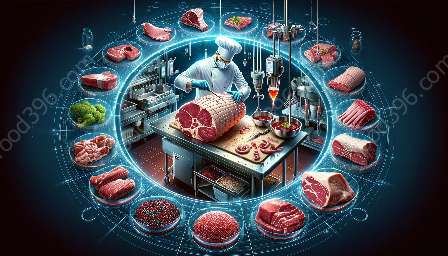Meat inspection and grading play crucial roles in ensuring the safety, quality, and traceability of meat products. This topic cluster provides a comprehensive guide to understanding the processes involved in inspecting and grading meat products, while also exploring the essential concepts of meat safety, hygiene, and the science behind meat products.
Meat Inspection
Meat inspection is a vital step in the meat production process, encompassing a range of activities conducted to ensure that meat products destined for human consumption are safe and wholesome. The inspection process involves stringent scrutiny of live animals, carcasses, and meat products to assess their fitness for consumption and to identify any potential hazards that could compromise food safety.
Objectives of Meat Inspection
The primary objectives of meat inspection are to prevent the spread of diseases, ensure the humane treatment of animals, and safeguard public health. Through meticulous examination and testing, inspectors aim to detect any abnormalities, disease conditions, or contamination that may render the meat unsafe for consumption.
Inspection Process
The inspection process involves visual examination, palpation, incision, and the collection of samples for laboratory analysis. It also includes evaluating the overall condition of the animals or meat products, assessing the presence of any abnormal odors, and identifying any signs of diseases or injuries.
Meat Grading
Meat grading is a standardized assessment of the quality and consistency of meat products, particularly in terms of tenderness, juiciness, and flavor. This process provides valuable information to both producers and consumers, helping them make informed decisions about purchasing and preparing meat products.
The Grading System
The grading system categorizes meat products based on specific criteria, such as marbling (intramuscular fat), maturity, and color. This categorization enables producers to classify their meat products according to the established standards, allowing for fair pricing and market differentiation.
Significance of Grading
Grading not only ensures quality and consistency but also facilitates the development of marketing strategies and supports the supply chain by aligning the products with consumer preferences. Additionally, it serves as a quality assurance mechanism, certifying that the meat products meet specific industry standards.
Meat Safety and Hygiene
Meat safety and hygiene are paramount considerations in the production, handling, and consumption of meat products. The implementation of strict protocols and sanitation practices aims to minimize the risk of foodborne illnesses and ensure that meat products are safe for human consumption.
Food Safety Practices
Food safety practices encompass various measures, including the proper storage of meat products, regular cleaning and disinfection of processing facilities, and adherence to temperature control requirements. Additionally, ensuring the health and welfare of livestock through appropriate vaccination and disease prevention measures contributes to safeguarding meat safety.
Hygienic Standards
Adhering to hygienic standards involves maintaining a clean and sanitized environment throughout the meat production process, from the farm to the processing plant and ultimately to the consumer. Stringent hygiene practices, such as handwashing, equipment sanitation, and pest control, are integral to minimizing the risk of contamination and ensuring the safety of meat products.
Meat Science
Meat science encompasses the study of the physical, chemical, and biological properties of meat, as well as the technological and engineering aspects of meat processing and preservation. Understanding the scientific principles underlying meat production and quality helps in optimizing processes and enhancing the nutritional value and sensory attributes of meat products.
Technological Advancements
Advancements in meat science have led to the development of innovative techniques for meat processing, preservation, and packaging. These advancements not only contribute to extending the shelf life of meat products but also enable the production of value-added products that meet consumer demands for convenience and diversity.
Nutritional Aspects
Exploring the nutritional aspects of meat products involves assessing their protein content, fat composition, vitamins, minerals, and other bioactive compounds. This understanding is instrumental in promoting the health benefits of consuming meat products and in addressing challenges related to obesity, malnutrition, and dietary imbalances.
Conclusion
Understanding the intricacies of inspection and grading of meat products is essential for ensuring their safety, quality, and compliance with regulatory standards. Moreover, integrating the principles of meat safety, hygiene, and meat science into the production and consumption of meat products is pivotal in promoting public health and consumer confidence. By delving into this topic cluster, individuals can gain valuable insights into the complexities of the meat industry, thereby making informed decisions as producers, consumers, and stakeholders in the food supply chain.

